AEP (Air-breathing Electric Propulsion)
Launchers and Propulsion
AEP (Air-breathing Electric Propulsion)
Background AEP Project References
In a world-first, an ESA-led team has built and fired an electric thruster to ingest scarce air molecules from the top of the atmosphere for propellant, opening the way to satellites flying in very low orbits for years on end. 1) 2) — Air-breathing electric thrusters could also be used at the outer fringes of atmospheres of other planets, drawing on the carbon dioxide of Mars, for instance.

Background
The genesis of the air-breathing EP (Electric Propulsion) idea, a potentially enabling drag-compensation technology for long duration missions in very low earth orbit (<250 km), can be traced back to the beginnings of the space age. Accordingly, most of the early concepts reflected the then prevailing view that nuclear power generators would rapidly find mainstream use in space. This was in particular the case of the pioneering work of Demetriades who promoted the PROFAC (Propulsive Fluid Accumulator System) concept, a spacecraft that would have been propelled by a MHD (Magnetohydrodynamics) thruster in the multi-MW (Microwave) range with the goal to collect, liquefy and store atmospheric gases in orbit. Other very high power concepts have been contemplated in the 1960s and 1970s as well as more recently, such as very large Hall thrusters in the 100 kW-1MW power range and operational altitude below 160 km. Contemporary studies have mostly focused, however, on low to medium power solar-electric designs. 3)
Starting from 2004, JAXA has had a sustained activity geared towards the development of the so-called ABIE (Air Breathing Ion Engine) concept in which an annular passive intake hosts the payload within its inner diameter and conducts air to an ion engine located at the rear7. This concept has been refined over the years8 and partially demonstrated with on-ground experiments in both pulsed and continuous intake flow conditions.
The ram-EP concept studied at ESA in 2007 shares some similarities with the ABIE concept but constitutes rather a broader, high level feasibility study with less focus on implementations details. It assumed a fairly generic reference design that could optionally include a compressor and a propellant storage unit11. It was followed by a technical assessment of the operation of conventional Hall thrusters and gridded ion thrusters with atmospheric propellants.
A number of studies with related but somewhat more restricted scopes have also been undertaken in the U.S. in recent years. A noteworthy attempt to solve an often overlooked issue is the demonstration of a microwave-powered cathode with a view to operate a complete EP system on atmospheric gases. A follow-up experimental investigation of a hybrid Hall thruster with ECR (Electron Cyclotron Resonance) ionization stage and a later similar effort at University of Michigan to develop an air-breathing hybrid RF Helicon Hall thruster have both reported issues which question the viability of the dual-stage approach.
Although it actually focuses on a prospective Mars atmosphere breathing mission, the MABHET (Martian Atmosphere-Breathing Hall Effect Thruster) study initiated in 2011 at Busek is one of few U.S. studies that specifically address the question of the intake design. Except for the use of CO2 as propellant and the somewhat lower Knudsen numbers, the MABHET concept is based on the same general principles as JAXA's ABIE or ESA's ram-EP. As in the aforementioned U.S. concepts, it is meant to be propelled by a Hall thruster.
ESA's GOCE (Gravity field and steady-state Ocean Circulation Explorer) gravity-mapper flew as low as 250 km for more than five years thanks to an electric thruster that continuously compensated for air drag. However, its working life was limited by the 40 kg of xenon it carried as propellant – once that was exhausted, the mission was over. — Replacing onboard propellant with atmospheric molecules would create a new class of satellites able to operate in very low orbits for long periods.
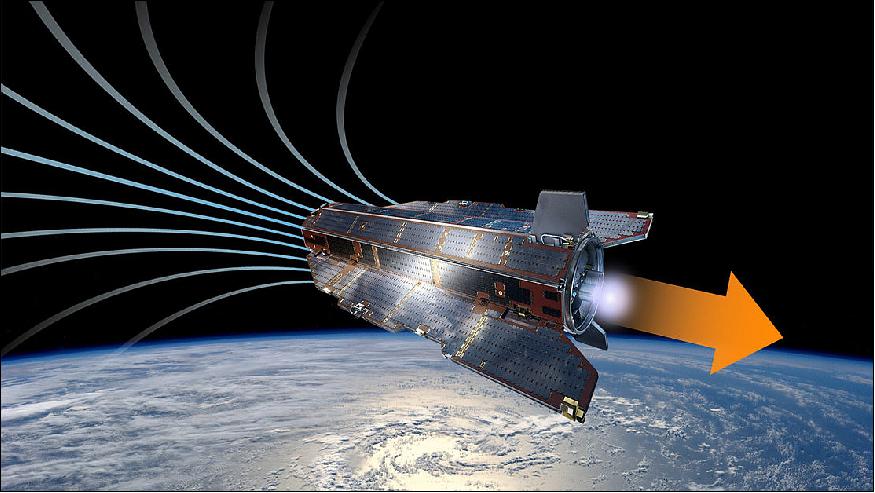
The AEP (Air-breathing Electric Propulsion) project began with a novel design to scoop up air molecules as propellant from the top of Earth's atmosphere at around 200 km altitude with a typical speed of 7.8 km/s," explains ESA's Louis Walpot.
A complete thruster was developed for testing the concept by Sitael Sp A in Pisa, Italy (Sitael HQs in Bari), which was performed in a vacuum chamber in their test facilities, simulating the environment at 200 km altitude. A ‘particle flow generator' provided the oncoming high-speed molecules for collection by the Ram-Electric Propulsion novel intake and thruster.
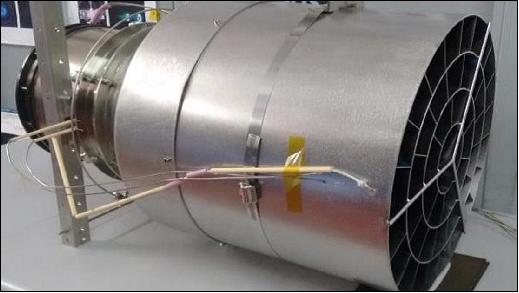
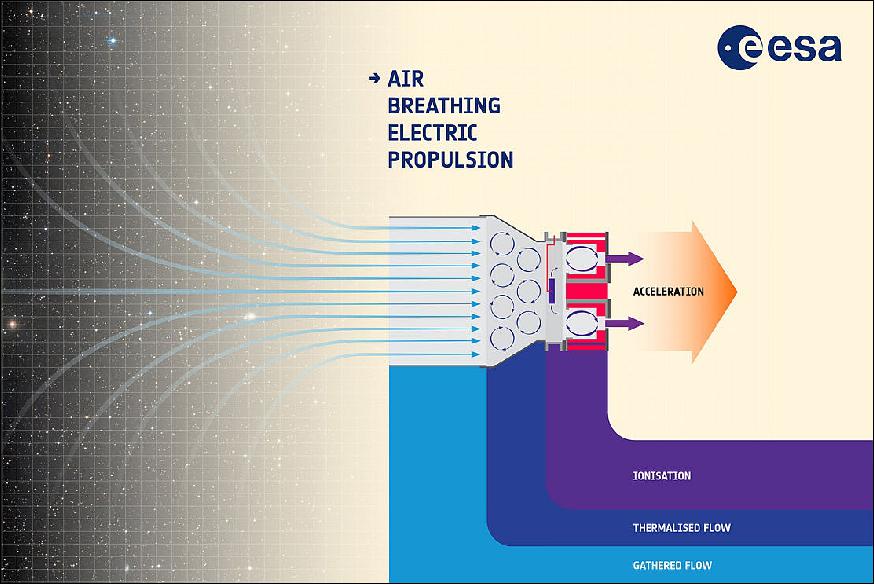
The challenge was to design a new type of intake to collect the air molecules so that instead of simply bouncing away they are collected and compressed.
The molecules collected by the intake designed by QuinteScience in Poland are given electric charges so that they can be accelerated and ejected to provide thrust.
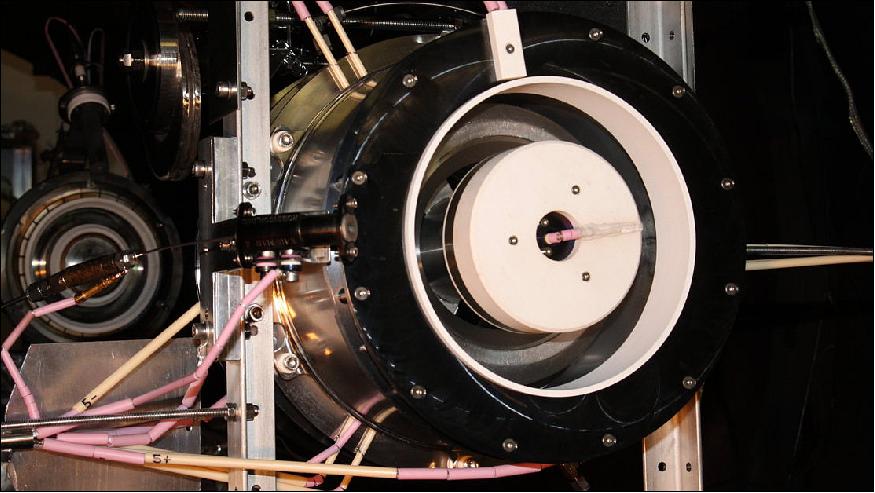
Sitael designed a dual-stage thruster to ensure better charging and acceleration of the incoming air, which is harder to achieve than in traditional electric propulsion designs.
"The team ran computer simulations on particle behavior to model all the different intake options," adds Louis, "but it all came down to this practical test to know if the combined intake and thruster would work together or not. Instead of simply measuring the resulting density at the collector to check the intake design, we decided to attach an electric thruster. In this way, we proved that we could indeed collect and compress the air molecules to a level where thruster ignition could take place, and measure the actual thrust."
"At first we checked our thruster could be ignited repeatedly with xenon gathered from the particle beam generator"(Figure 6). As a next step, Louis explains, the xenon was partially replaced by a nitrogen–oxygen air mixture: "When the xenon-based blue color of the engine plume changed to purple, we knew we'd succeeded . The system was finally ignited repeatedly solely with atmospheric propellant to prove the concept's feasibility."
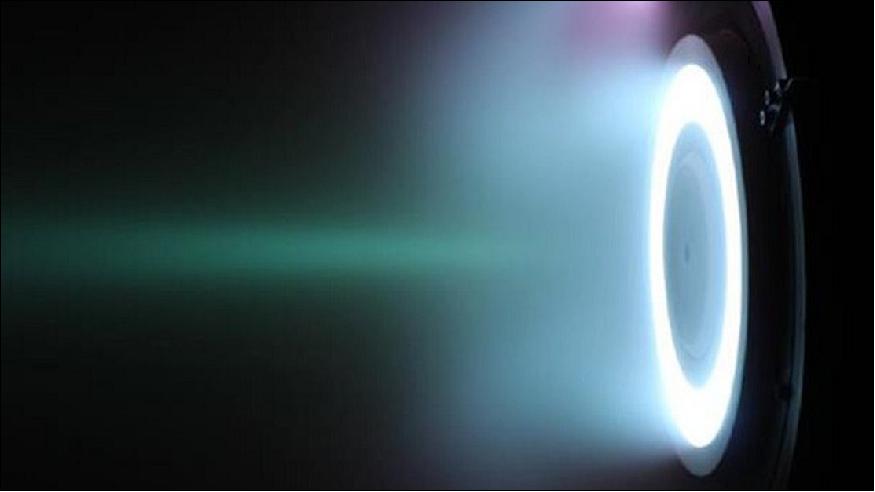
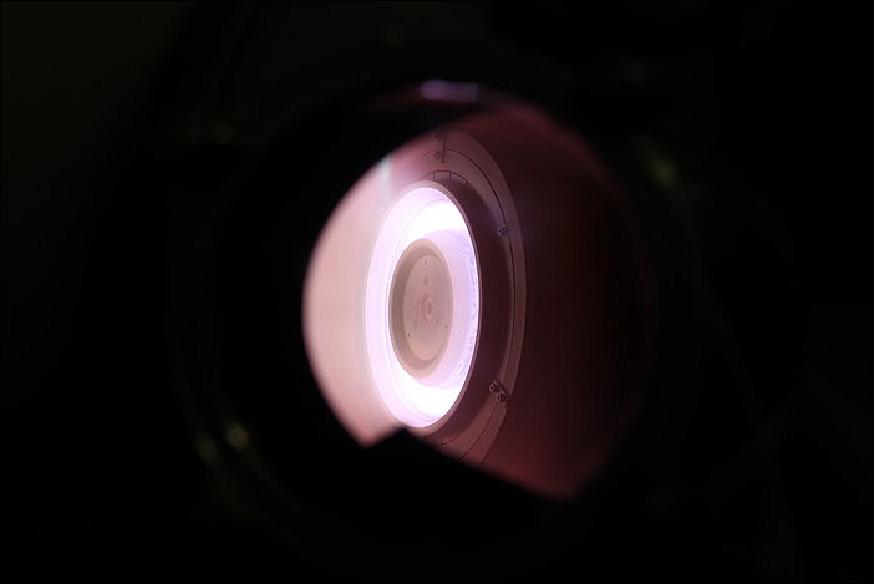
"This result means air-breathing electric propulsion is no longer simply a theory but a tangible, working concept, ready to be developed, to serve one day as the basis of a new class of missions."
This project was backed through ESA's TRP (Technology Research Program) for developing promising new ideas for space, with the support of the Agency's Earth Observation Program.
References
1) "World-first firing of air-breathing electric thruster," ESA, 5 March 2018, URL:
http://m.esa.int/Our_Activities/Space_Engineering_Technology
/World-first_firing_of_air-breathing_electric_thruster
2) "Electric Propulsion," Sitael, URL:
http://www.sitael.com/space/advanced-propulsion/electric-propulsion/
3) Serge Barral, Gianluca Cifali, Riccardo Albertoni, Mariano Andrenucci, Louis Walpot, "Conceptual Design of an Air-Breathing Electric Propulsion System," Joint Conference of 30th International Symposium on Space Technology and Science 34th International Electric Propulsion Conference and 6th Nano-satellite Symposium, Hyogo-Kobe, Japan, July 4 - 10, 2015, URL: http://erps.spacegrant.org
/uploads/images/2015Presentations/IEPC-2015-271_ISTS-2015-b-271.pdf
The information compiled and edited in this article was provided by Herbert J. Kramer from his documentation of: "Observation of the Earth and Its Environment: Survey of Missions and Sensors" (Springer Verlag) as well as many other sources after the publication of the 4th edition in 2002. - Comments and corrections to this article are always welcome for further updates (eoportal@symbios.space).